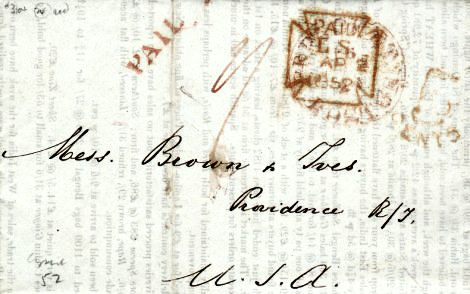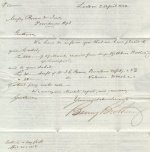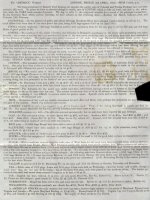![]()
Home Page
Postal History Introduction
Stampless
Covers
1846
to 1900 Issues
1901-1950
Issues
1951-2003
Issues
Cancels
&
Miscellaneous
Postal
Stationery
Post
Cards
Air
Mail
First
Day &
Event Covers
Parcel Post/Special Delivery
Registered & Official Mail
Commercial & Advertising
Revenue & Postage Due
Wildlife & Game Issues
Complete List of RI Issue
|
Rhode Island Stampless
Covers & Letters |
||||
|
||||
|
The first member of the Rhode Island Browns
to settle in America was the Reverend Chad Brown, who arrived in Boston on the
ship Martin in July 1638 with his wife Elizabeth and 8 year old
son John. However, Chad did not remain long in the Massachusetts Bay
Colony; moving to Providence, Rhode Island that same year. Chad Brown's great grandsons, James II and Obadiah Brown were the original founders of the Brown family fortune. They entered the Triangular Trade, (Slaves, Rum & Sugar) in 1736 with their sloop Mary. The Brown family was engaged off an on in the slave trade until around 1819. They were also heavily engaged in the China Tea trade and trade to Europe and the East Indies. |
||||
|
Four of James' sons; Nicholas Sr., Joseph, John, and Moses became known as The Four Brothers and further established the family's mercantile wealth and power, (Nicholas Brown & Company). The firm was later joined by George Benson (Brown and Benson). The Brown family was one of the most successful merchant families in the history of Rhode Island and certainly one of the wealthiest. Although the Brown family fortunes began with their shipping empire, by the 1830's the family's shipping interests were minimal and most of their enterprises were centered around the booming Rhode Island and New England textile industry. The Brown family owned textile mills throughout Rhode Island and New England and in addition were owners and operators of several machine and tool companies. Nicholas Brown, Jr. was born on April 4, 1769 in Providence, Rhode island. He was a graduate of Brown University. Nicholas and Thomas Poynton Ives, (his sister's husband) founded the firm of Brown and Ives. For over forty years the firm of Brown and Ives was one of the leading mercantile firms in the country and it's name was known throughout the world. Nicholas died on September 27, 1841 and at the time this letter was sent the firm was being run by his son, John Carter Brown. Notes: John Brown remained in the slave trade into the early 1800s. In 1797 the Providence Abolition Society, of which both Moses and Obadiah Brown were members, brought suit against brother John under the new 1794 Federal anti-slavery law, which prohibited any ships that transported slaves from outfitting in American ports. The vessel in question was condemned, however John escaped unscathed and even received compensation for his loss. He later stated that, "The people in general are against this wicked and abominable combination," (referring to the Abolition Society). Moses Brown became a Quaker and denounced anything to do with the slave trade. He also was instrumental in the early success of the textile industry, having supplied the funding for Samuel Slater's first Water Powered Textile Mill in Pawtucket in 1793. Nicholas Brown Jr. also refused to have anything to do with, or become involved in the slave trade. In 1796 Nicholas and Thomas began construction of a second large ship to use in the Far Eastern Trade, (their first was the John Jay). The ship was named Ann & Hope after the partner's two wives and was one of the fastest vessels of her time. The original Ann & Hope wrecked off Montauk Point in 1806 and the partners built a second ship of the same name launched in 1807. The second Ann & Hope was engaged in the Far Eastern Trade until at least 1838. In 1886 the largest textile mill of it's time was built in Lonsdale, Rhode Island and was also named after the wives of the original Brown & Ives partners. The Ann & Hope Mills was in operation until 1930. In 1953 the first discount department store in the country, Ann & Hope of Rhode Island opened for business. |
||||
|
London 2 April 1852
Gentlemen, Barring Brothers and
Appended at Bottom of Letter by
Brown & Ives |
||||
|
See below links for further information: The History of Brown and Ives with Brown family Genealogy 1789 Brown and Benson Letter from Champion and Dickason - London 1834 Brown & Ives Letter from Amsterdam Factor 1852 Brown & Ives Letter from Baring Brothers - London, England Brown and Ives Family of Providence - Covers & Letters |
||||

RI Historical
Society
Introduction
Stampless I
Stampless II
Stampless III
Stampless IV
Stampless V
Stampless VI
Brown & Ives Letters
The Hazard Family Letters
Joseph Tillinghast
Free Franked Letters
DeWolf Family Letters
Recently Added Pages


